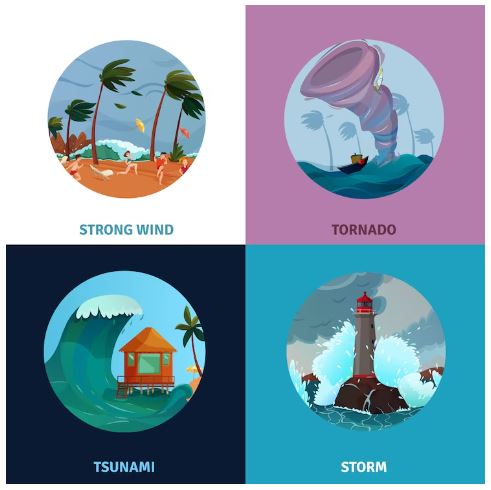
Natural disasters are catastrophic events that occur as a result of natural phenomena such as weather patterns, geological disturbances, and other natural processes. These events can wreak havoc on the environment, causing widespread destruction and loss of life. Understanding what a natural disaster is and how it occurs is crucial in mitigating its impact and preparing for future occurrences. In this article, we will delve into the world of natural disasters, exploring their causes, effects, and the steps that can be taken to minimize their impact.
Types of natural disasters
Natural disasters come in many forms, each with its unique set of characteristics and effects. Some common types of natural disasters include floods, hurricanes, earthquakes, tsunamis, wildfires, and volcanic eruptions. Floods occur when water overflows from rivers, lakes, or oceans, causing extensive damage to infrastructure and property. Hurricanes are powerful storms that can cause flooding, landslides, and wind damage, while earthquakes can cause buildings and infrastructure to collapse. Tsunamis are caused by seismic activity in the ocean, resulting in massive waves that can devastate coastal communities. Wildfires can be caused by natural or human factors and can spread quickly, destroying homes and habitats. Volcanic eruptions can cause ash and lava flows that can destroy entire communities.
It’s important to note that natural disasters can be classified as sudden-onset or slow-onset. Sudden-onset disasters, such as earthquakes and hurricanes, occur quickly and with little warning. Slow-onset disasters, such as droughts and desertification, occur gradually over a more extended period and can be just as devastating.
Causes of natural disasters
Natural disasters are caused by various natural phenomena, including weather patterns, geological disturbances, and other natural processes. Weather patterns, such as hurricanes and tornadoes, are caused by temperature and pressure changes in the atmosphere. Geological disturbances, such as earthquakes and volcanic eruptions, are caused by the movement of tectonic plates and the release of pressure within the earth’s surface. Other natural processes, such as wildfires and floods, can be caused by natural factors such as lightning strikes or human factors such as land use practices.
Impacts of natural disasters
Natural disasters can have a significant impact on the environment, people, and the economy. Loss of life and injury are the most immediate and tragic impacts of natural disasters. Property damage is also a significant impact, with homes, businesses, and infrastructure destroyed or severely damaged. Natural disasters can also lead to economic losses, with businesses and industries disrupted, and tourism and trade affected. Disasters can also cause environmental damage, with habitats destroyed, and natural resources depleted.
How to prepare for a natural disaster
Emergency preparedness is essential in mitigating the impact of natural disasters. Having a plan in place can help individuals and communities respond quickly and effectively in the event of a disaster. This can include developing an evacuation plan, having an emergency kit, and staying informed about weather patterns and other natural phenomena. It’s also important to have a communication plan in place with family and friends to ensure that everyone is safe and accounted for. Communities can also develop emergency response plans and designate evacuation routes and shelters.
Response to natural disasters
Emergency response is crucial in the aftermath of a natural disaster. This can include search and rescue operations, providing medical care and supplies to survivors, and restoring essential services such as power and water. Disaster relief efforts can also provide temporary housing, food, and other necessities to those affected by a disaster. Governments, non-governmental organizations, and community groups can work together to coordinate response efforts and ensure that resources are distributed effectively.
Natural disaster statistics
Natural disasters are becoming more frequent and severe, with climate change and other human factors contributing to their intensity. According to the World Bank, natural disasters have caused $1.3 trillion in damage globally over the past 20 years. In 2019 alone, natural disasters caused $150 billion in damage and affected over 140 million people. The impacts of natural disasters are felt most acutely in developing countries, where infrastructure and emergency response systems are often inadequate.
Mitigating the effects of natural disasters
Reducing the impact of natural disasters requires a combination of structural and non-structural measures. Structural measures can include building codes and standards that ensure buildings and infrastructure can withstand natural disasters. Non-structural measures can include disaster management strategies such as early warning systems and community preparedness programs. Climate change mitigation efforts can also help reduce the frequency and severity of natural disasters by reducing greenhouse gas emissions and other factors that contribute to climate change.
Coping with the aftermath of a natural disaster
The aftermath of a natural disaster can be challenging, with individuals and communities facing physical, emotional, and economic impacts. Mental health support is essential in helping survivors cope with the trauma and stress of a disaster. Rebuilding efforts can also help communities recover and rebuild, with governments and non-governmental organizations providing resources and support to those affected.
Conclusion
Natural disasters are devastating events that can have significant impacts on the environment, people, and the economy. Understanding the causes and effects of natural disasters is crucial in mitigating their impact and preparing for future occurrences. Emergency preparedness, effective emergency response, and disaster relief efforts are essential in reducing the impact of natural disasters. Mitigating the effects of natural disasters and rebuilding efforts can help communities recover and rebuild after a disaster. By working together and taking proactive steps, we can reduce the impact of natural disasters and ensure that communities are prepared to respond and recover.


